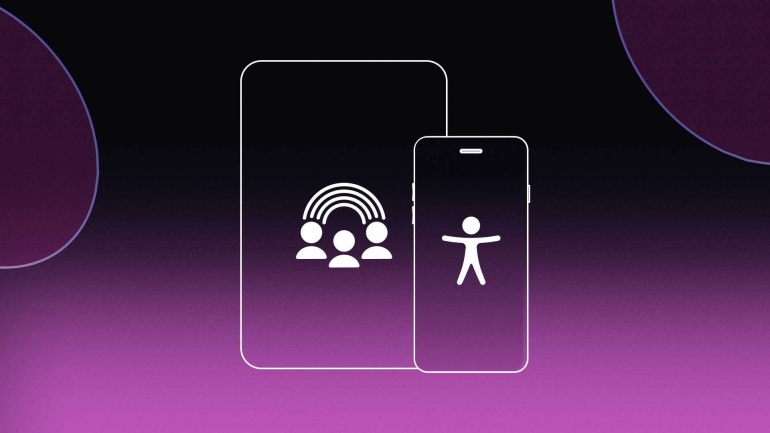Web overlays are the subject of ongoing heated conversations in the digital accessibility compliance universe. There has been reluctance and fear to embrace overlays as tools that assist in creating more inclusive online spaces. These fears are based on the belief that these products harm, rather than help people with disabilities.
Making websites accessible is the first and last goal; that should be clear. Working to build better technology when it affects so many people is part of that long-term objective. Accessibility is very personal, and very necessary. People are hurt when websites don’t work. A fair-sized percentage of the population has disabilities of various kinds, some of which may not be obvious. Others have people they care about who are disabled.
This complete guide presents an overview of website accessibility options and what overlays are; the current heated debate revolving around the use of web overlays in web accessibility compliance; and common questions and concerns raised when discussing this technology.
What is an Accessibility Overlay?
The odds that you’ve encountered an overlay on a website are high. Some website overlay examples include chatbots, calls-to-action prompted by certain mouse movements, promotional pop-up notifications (nobody loves those), or tools to navigate the page and share content on social media.
So what exactly is an overlay? It’s a highly leveraged, usually Javascript-powered site download that rests on the “edge” of a website, or on top of the final layer of viewable information. Sitting “on the edge” allows page overlays to execute a variety of functions in the liminal space between the site and the end user.
Overlays can provide web accessibility features such as:
- User-activated customization: An overlay accessibility widget features a hovering on-screen interface where a user has access to a number of accessibility features, including an array of adjustments. These can include fine-tuning options such as text, changing contrast, highlighting links, and other personalization choices.
- Accessibility violation detection As an overlay interacts with a website’s code, it can detect WCAG violations, including missing alt text, improper focus (such as an outline that may appear upon selecting or hovering over a button), and missing tab navigation.
- Error remediation: When code problems are detected, an overlay can correct many of them to bring them up to WCAG standards. Machine learning has made it possible for an overlay to generate alt tags through image recognition. It can often automatically reorder heading tags to correct page hierarchy as well.
- Promote disability awareness: End users become more aware of digital accessibility issues when they regularly notice widgets on the overlay websites they navigate every day. Overlays can also offer vital, real-time information on violations, and opportunities to fix them to make your website more accessible.
Current Heated Conversations & Overlays Arguments
There are typically three objections raised when discussing web accessibility overlays. These include:
- Overlay companies make deceptive claims about their products
- Manual coding and remediation are superior
- Accessibility overlays hurt, rather than help, people with disabilities
Claim 1: Overlays Are Deceptive
Argument one, regarding deceptive claims, is a very general claim. It involves the quality of specific products and the ethics of the company providing them. The way that individual web overlays are marketed and used cannot be the basis of avalid argument for completely banning the technology for accessibility usage. Overlay software has many valuable uses, and banning a working technology because of poor actors who oversell their company’s product would be an unfortunate loss for the accessibility community.
The International Association of Accessibility Professionals (IAAP) has said that companies should refrain from claiming a website or application can be made fully accessible simply by installing a plugin or widget, without requiring additional steps or services. Disability advocacy organizations like the IAAP and the World Wide Web Consortium (W3C) are well positioned to address deceptive practices in their membership as well as generally.
Claim 2: Manual Remediation is Better
Traditional and legacy accessibility solution companies have a vested interest in promulgating the claim that manual remediation is better. These businesses are of the opinion that overlays are faulty, and hand coding will always be better than automated solutions, even at a large scale.
This kind of claim once again lumps all accessibility overlay products together, but fails to acknowledge that there are many overlay and AI products on the market. They all offer a spectrum of services and performance. While it is true that human remediation is currently more comprehensive than many overlay products, this claim also ignores the fact that overlay technology is improving every day, and machine learning will one day overtake manual ability. It should also be obvious that manual remediation is limited when it comes to addressing large sites with possibly thousands of pages of content.
Claim 3: Overlays Are More Harm Than Help
This claim, once again, fails to acknowledge the varying performance levels among accessibility overlay vendors. Ultimately, this claim requires a burden of proof that simply has not been satisfied yet. More data is needed before a blanket statement can be made that all overlays interfere with assistive technologies. Collecting this type of information could be achieved by testing a random sample of sites, with various overlay brands activated and deactivated.
Do Accessibility Overlays Work?
Bottom line: How functional are accessibility overlays for the end user? A better (or clearer) question here would be, “do overlays work as they are typically marketed?”
If a company is marketing their overlay product with the claim that an overlay will instantly bring a website into WCAG compliance, then as of now, no, overlays do not “work” in that sense. However, if overlays are being promoted as assistive tools that jumpstart compliance, and make the remediation process more efficient, then yes, overlays absolutely do work. It’s not 100% compliance, and it’s not plug, play, and ignore. With some human input, overlays can bring a tremendous improvement to accessibility levels, especially on large websites, or sites that aren’t going to fix accessibility issues by hand at all.
The World Wide Web Consortium’s current WCAG 2.X paradigm literally stipulates that web solutions must be perfect, or they are not conformant. This standard is extreme even for human remediation. Modern websites are built on dynamic content, with sometimes as many as 30 plugins running simultaneously. That makes a pass/fail dichotomy unrealistic. There really should be a category for “improving”, “improved accessibility”, or “good enough for now,” to designate where a website stands on its accessibility journey.
Are Website Background Overlays the Ultimate Accessibility Tool?
With machine learning and evolving technology, overlays are emerging as a dominant tool for web accessibility compliance. Overlays offer a mechanism for remediating the majority of websites, at least to some degree, in a timely and cost-effective manner.
At present, there are pitfalls in attempting to fully automate web accessibility. Some errors are going to be missed; some AI remediations are inaccurate or faulty. This is why manual review and user testing are critical steps in the ethical use of web accessibility tech. Some of the most vocal overlay opponents have implemented their own automation into assisting in their remediation process. They will argue that their automation is acceptable simply because it isn’t implemented as an overlay layer.
Even when coming from a perspective of accessibility-first development efforts, websites change all the time, and content is updated throughout the lifetime of the site. While front-end accessibility work is a strong advantage for sites, there is no guarantee that newly published versions of their site will maintain compliance. It’s also not a given that the standards a site was meant to meet when it was created won’t change in the future. Web accessibility overlays supply continual site monitoring that ensures new content meets the most currently applicable standards.
Do Overlays Address or Cover Up Actual Problems?
There are three ways changes are put into place through overlays:
- Automated overlays in website remediations can make code-level adjustments and alterations to a fully-loaded webpage, bring sites closer to compliance with WCAG standards.
- Overlays can alert web developers to violations on websites, and offer recommendations for how to correct them, and even AI-generated suggestions. These alerts are reviewable, and can address immediate accessibility failures.
- An accessibility overlay in a website can provide user-triggered customizations, so site visitors can custom-tailor their site experience. Potential problems such as poor color contrast, and even small text, can be adjusted by simply selecting appropriate changes in the widget interface.
Does a Website Overlay Create Data Privacy Issues?
Privacy protection is a potential area of risk when dealing with web overlays. Some of them may attempt to detect and collect user information. Some products do store user data, and automatically trigger the same preferences when that individual visits a third-party site using the same overlay product.
Once again, these concerns are generally dependent on the company providing the website background overlay. Most sites publicly post privacy policies, where they provide disclaimers for their practices concerning users and anonymized data.
Will an Overlay in a Website Prevent You From Being Sued?
This is largely a question about the quality of the product you’ve chosen, and how it is implemented. Generally speaking, free accessibility overlay products will not be robust enough to bring a website into full WCAG compliance, or provide shelter from litigation.
Even when a paid web accessibility overlay subscription is purchased, if the product is strictly automated and does not offer manual review interactions and prompts, there will likely be incomplete and inaccurate remediations. If site owners do not perform their due diligence to follow prompts and make changes when alerted, the overlay will likely not provide proper accessibility compliance.
Overlay Takeaways
To sum it up: overlays are only a small cog in the overall development architecture of accessible websites and the general quality of life of people with disabilities, as well as people who have situational and temporary disabilities. As AI tech continues growing to provide human-level functionality, web page overlays should be used in the larger context of web accessibility best practices — accessibility-minded development, manual reviews, and user testing.
Considering that the vast majority of websites worldwide remain inaccessible to people with disabilities, and the monetary and time demands of traditional remediation are cost-prohibitive for most, the solutions overlays provide answer a real demand. And the fact that overlays are generating large net positives for accessibility where there is overwhelming noncompliance is something that should be celebrated, not feared or dismissed. Innovation must inevitably lead to more accurate and effective web accessibility overlays in time.



